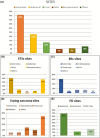Multidisciplinary management of adolescents and young adults (AYA) sarcoma: A successful effort of an adult high-volume cancer center
- PMID: 37366268
- PMCID: PMC10469812
- DOI: 10.1002/cam4.6289
Multidisciplinary management of adolescents and young adults (AYA) sarcoma: A successful effort of an adult high-volume cancer center
Abstract
Introduction: The aim of this retrospective study was to investigate the clinicopathological characteristics of AYA sarcomas and their clinical outcomes at a high-volume single center.
Methods: Demographic, clinicopathological data on the diagnosis, treatment and follow-up of all sarcoma patients aged 16-39 years (ys) observed at our Institute between January 2010 and December 2021 were retrospectively collected, including diagnostic (TTD) and treatment delay(TTT), clinical outcomes (OS and PFS), and late-treatment effects.
Results: We identified 228 AYA patients, median age 30 years, 29% ≤ 25 years, 57% males, 88% soft tissue sarcomas (STS), and 12% bone sarcomas (BS). Among STSs, 13% were small round cell tumors (SRCT), 52% intermediate-high-grade, 24% low-grade STSs. Among BS, 32% were high-grade. Median TTD and TTT were 120 (0-8255) and 7 days (0-83), respectively. Surgery was performed in 83%, radiotherapy in 29%, and systemic therapy in 27%. Median follow-up was 72.9 months(1.6-145), 5-year and 10-year OS were 78.5% and 62%, respectively. Kaplan-Meyer analysis showed a significantly better 5-year OS and PFS for patients with >92 days of TTD (OS 85.7% vs. 66.7%, p = 0.001, PFS 50.2% vs. 24.9%, p = 0.009). According to age (≤25 years vs. > 25 years), 5-year OS was 69.8% versus 82.2%, respectively (p = 0.047).
Conclusion: Our analysis confirmed previous data on sarcoma AYA patients followed in a referral center. Unexpectedly, diagnostic delay was not associated with poor OS and PFS. Patients <25 years showed a poorer prognosis due to the higher incidence of SRCT.
Keywords: AYA; adolescent; oncology; sarcoma; young adult.
© 2023 The Authors. Cancer Medicine published by John Wiley & Sons Ltd.
Conflict of interest statement
The authors declare no conflict of interest.
Figures






Similar articles
-
Descriptive epidemiology and outcomes of bone sarcomas in adolescent and young adult patients in Japan.BMC Musculoskelet Disord. 2018 Aug 18;19(1):297. doi: 10.1186/s12891-018-2217-1. BMC Musculoskelet Disord. 2018. PMID: 30121085 Free PMC article.
-
Analysis of bone and soft-tissue sarcomas registered during the year 2012 at Tata Memorial Hospital, Mumbai, with clinical outcomes.Indian J Cancer. 2018 Jan-Mar;55(1):37-44. doi: 10.4103/ijc.IJC_481_17. Indian J Cancer. 2018. PMID: 30147091
-
Secondary malignant neoplasms after bone and soft tissue sarcomas in children, adolescents, and young adults.Cancer. 2022 May 1;128(9):1787-1800. doi: 10.1002/cncr.34110. Epub 2022 Feb 23. Cancer. 2022. PMID: 35195899
-
Sarcomas of Soft Tissue and Bone.Prog Tumor Res. 2016;43:128-41. doi: 10.1159/000447083. Epub 2016 Sep 5. Prog Tumor Res. 2016. PMID: 27595362 Review.
-
Overview of sarcomas in the adolescent and young adult population.J Pediatr Hematol Oncol. 2005 Apr;27(4):215-8. doi: 10.1097/01.mph.0000161762.53175.e4. J Pediatr Hematol Oncol. 2005. PMID: 15838394 Review.
Cited by
-
Peer2Me - impact of peer support on self-efficacy in young adult cancer survivors (YA-CS): findings from a comprehensive cohort design.BMC Cancer. 2025 May 26;25(1):943. doi: 10.1186/s12885-025-14323-5. BMC Cancer. 2025. PMID: 40420294 Free PMC article. Clinical Trial.
References
Publication types
MeSH terms
LinkOut - more resources
Full Text Sources
Medical
Research Materials

